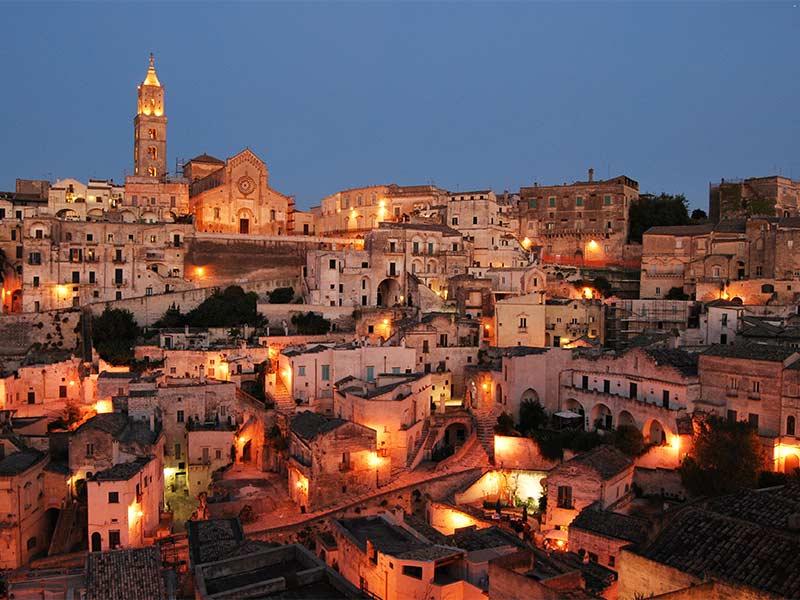Words by Nicola Zicari - Pictures by Felix Petrelli and John Heseltine
Until 20 years ago Matera was considered a ‘national disgrace’ by the Italian government. All this has changed.
Matera is now surrounded by a flourishing industrial zone that has brought about the rebirth of the ancient city. This town is full of smart, young entrepreneurs who have created their businesses from next to nothing.
Matera has become a leader in Italian furniture production which are giving jobs to the young, skilled workforce. Great for their bank accounts and even better for the local economy, which is thriving.
Resurgence of the Sassi
 Until 1953 the Sassi was home to 20,000 people – peasants, landowners, shepherds, artisans and merchants. Then overpopulation caused the collapse of the water and sewerage systems and the resulting decline in hygiene forced the Italian government to declare Matera a ‘national disgrace’.
Until 1953 the Sassi was home to 20,000 people – peasants, landowners, shepherds, artisans and merchants. Then overpopulation caused the collapse of the water and sewerage systems and the resulting decline in hygiene forced the Italian government to declare Matera a ‘national disgrace’.
Its inhabitants were transferred to new districts and the Sassi di Matera became the largest completely abandoned historical centre in Italy. The turnaround came in 1993 when Matera was the first town in southern Italy to be included in the UNESCO World Heritage list.
The derelict town was declared the most outstanding, intact example of a troglodyte settlement in the Mediterranean region.Thanks to government grants for regeneration, nearly 70 percent of the abandoned old town – the Sassi - has been restored.
The Sassi is the real star of Matera, and myriad new business activities have transformed this former ghost town into a vibrant urban centre and tourist attraction, complete with hotels, pubs and clubs.
It’s not by chance that Mel Gibson has decided to shoot his forthcoming film ‘The Passion’ in the Sassi of Matera (with Italian film star Monica Bellucci). He reportedly loved living here, eating and mingling with the locals and savouring the modern life of a prehistoric town.
Miserable Past
 Sassi means stones in Italian, and the old town itself is a jumble of houses, caves and chapels set into a funnel-shaped spiral of labyrinthine alleys, half a kilometre across and 100 metres deep.
Sassi means stones in Italian, and the old town itself is a jumble of houses, caves and chapels set into a funnel-shaped spiral of labyrinthine alleys, half a kilometre across and 100 metres deep.
This funnel was home to humans from pre-historic times until 50 years ago. The first houses were made by digging the natural grottoes and later by adding limestone bricks. The houses are stacked so that each forms the roof of one and the base of another.
The Sassi is more like Jerusalem than Naples, white-washed and shimmering in the heat, where traffic is limited to a few Fiats, and of course the ubiquitous scooters. ‘What I remember is a picture of misery,’ my father explains to me whenever we talk about his childhood. ‘In those black holes with stone walls I can still see the miserable furnishings and the rags hanging up to dry.
 Dogs, sheep, goats and pigs were stretched out on the floor. Each family had a single-room cave to live in. We all slept together: men, women, children and animals. This was how we lived.’
Dogs, sheep, goats and pigs were stretched out on the floor. Each family had a single-room cave to live in. We all slept together: men, women, children and animals. This was how we lived.’
Between the 8th and 13th century the caves were taken over by monks escaping religious persecution. By the 15th century peasants and their animals had moved into the cave dwellings abandoned by the monks.
They excavated the natural caves to build more rooms. The first room from the main entrance was the living room and often bedroom. Niches were cut out of the back wall to catch the rays of the sun and reflect them into the room. A few steps down a stone manger indicates that animals were kept here.
The lowest rooms were caverns used as cellars for food and wine. My great uncle who lived in a cave for more than 20 years, explained, ‘with this structure, to steal animals, any thieves had to pass through the bedroom. Its hard to herd three noisy goats past their sleeping owner.’
Food for Thought
Here in Matera, society is changing. Family values have been globalised. Women’s roles are changing. People have the Internet, mobile phones and satellite TV. But traditions are still deeply rooted inside their hearts – and their bellies. And eating is the most popular tradition, especially on Sundays, when Mamma invites their children, even if already married and with kids of their own.
What to see in Matera
 Wandering in the Sassi ‘streets’ you can read the story of the people that lived among these rocks, but if would like to have a complete overview of the Sassi's story, three places are worth a visit:
Wandering in the Sassi ‘streets’ you can read the story of the people that lived among these rocks, but if would like to have a complete overview of the Sassi's story, three places are worth a visit:
Ridola Museum: where are collected decorated pottery, stone tools, sarcophagi with crockery, necklaces, coins, statues, arrowheads and tips of lances from around 400,000 years ago
Tavole Palatine Temple: just ten minutes drive from Matera, get the chance to see a place where the Greek Empire stretched well into the region and Pythagoras taught maths.
The monasteries and rock-hewn churches: complete with icons, pulpits, altars and frescoes that the religious refugees created in the caves.





